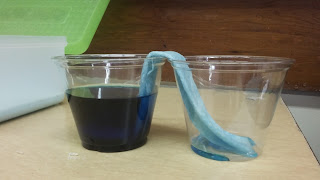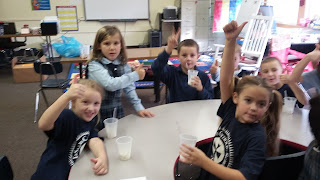Wednesday, November 23, 2016
Tuesday, November 15, 2016
Capillary Action
 |
| We learned about Capillary Action by draping a folded paper towel between a cup filled with colored water and an empty cup. |
 |
| The colored water traveled up the paper towel into the empty cup. |
 |
| Each child experimented with capillary action by placing a Smartie on a coffee filter and then dripping water on top. |
 |
| It is hard to see, but the colors from the Smarties spread out as the water was attracted towards the edge of the filter. |
Tuesday, November 1, 2016
We All Scream for Ice Cream!
 |
| Everyone thought the ice cream was great. |
 |
| We had extra time to do an engineering challenge: fold a piece of construction paper into a column that will support books placed upon it. |
 |
| The students worked in teams and used trial and error. |
 |
| This team is testing its column. Each team submitted its best column and we measured the strength by adding books one at a time. So far the strongest column supported 25 paperback books! |
Tuesday, October 25, 2016
Physical and Chemical Changes
 |
| We agreed that making chocolates from chocolate wafers was a physical change. |
 |
| We melted the wafers and poured it into candy molds with Halloween sprinkles. |
 |
| Then we chilled the chocolate until it was hard. The substance didn't change but the shape did- a physical change. |
 |
| We broke pretzels to show physical change then... |
Tuesday, October 18, 2016
Floating Marshmallows and Paper Test
 |
| We used our knowledge of density to try making marshmallows sink in water instead of floating. |
 |
| This student took two tries to get one to sink. |
 |
| The students tried different things: breaking the marshmallow apart, flattening it, and squishing it into a small ball. |
 |
| Today our other quest was to find out which foods had the most fat in them. Each child selected a food and then mashed it between two sheets of paper. |
 |
| The foods that turned the paper translucent had the most fat in them. This is the butter test. |
 |
| We were not surprised that peanut butter had a lot of fat. |
Floating Marshmallows and Paper Test
 |
| We used our knowledge of density to try making marshmallows sink in water instead of floating. |
 |
| This student took two tries to get one to sink. |
 |
| The students tried different things: breaking the marshmallow apart, flattening it, and squishing it into a small ball. |
 |
| Today our other quest was to find out which foods had the most fat in them. Each child selected a food and then mashed it between two sheets of paper. |
 |
| The foods that turned the paper translucent had the most fat in them. This is the butter test. |
 |
| We were not surprised that peanut butter had a lot of fat. |
Tuesday, October 11, 2016
 |
| Today we learned what dehydrating means and why it was used to preserve food in the past. |
 |
| We used a crank apple corer/slicer to prepare apples for dehydration. |
 |
| The apples were spread on a tray on the food dehydrator. |
 | ||||
| I also purchased some dried vegetables but they were not a big hit. :-) We had some time leftover so each child chose a Lego challenge card and used Legos to complete the challenge.  
|
Subscribe to:
Posts (Atom)



















